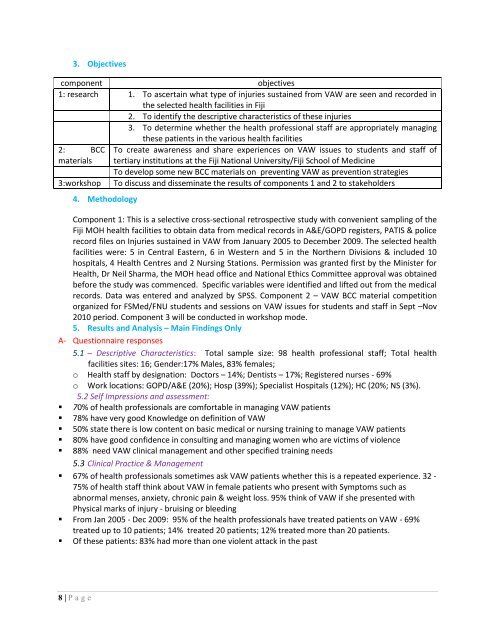Project Report â Fiji 2010 - Pacific Health Voices
Project Report â Fiji 2010 - Pacific Health Voices
Project Report â Fiji 2010 - Pacific Health Voices
Create successful ePaper yourself
Turn your PDF publications into a flip-book with our unique Google optimized e-Paper software.
3. Objectives<br />
component<br />
objectives<br />
1: research 1. To ascertain what type of injuries sustained from VAW are seen and recorded in<br />
the selected health facilities in <strong>Fiji</strong><br />
2. To identify the descriptive characteristics of these injuries<br />
3. To determine whether the health professional staff are appropriately managing<br />
these patients in the various health facilities<br />
2: BCC To create awareness and share experiences on VAW issues to students and staff of<br />
materials tertiary institutions at the <strong>Fiji</strong> National University/<strong>Fiji</strong> School of Medicine<br />
To develop some new BCC materials on preventing VAW as prevention strategies<br />
3:workshop To discuss and disseminate the results of components 1 and 2 to stakeholders<br />
4. Methodology<br />
Component 1: This is a selective cross-sectional retrospective study with convenient sampling of the<br />
<strong>Fiji</strong> MOH health facilities to obtain data from medical records in A&E/GOPD registers, PATIS & police<br />
record files on Injuries sustained in VAW from January 2005 to December 2009. The selected health<br />
facilities were: 5 in Central Eastern, 6 in Western and 5 in the Northern Divisions & included 10<br />
hospitals, 4 <strong>Health</strong> Centres and 2 Nursing Stations. Permission was granted first by the Minister for<br />
<strong>Health</strong>, Dr Neil Sharma, the MOH head office and National Ethics Committee approval was obtained<br />
before the study was commenced. Specific variables were identified and lifted out from the medical<br />
records. Data was entered and analyzed by SPSS. Component 2 – VAW BCC material competition<br />
organized for FSMed/FNU students and sessions on VAW issues for students and staff in Sept –Nov<br />
<strong>2010</strong> period. Component 3 will be conducted in workshop mode.<br />
5. Results and Analysis – Main Findings Only<br />
A- Questionnaire responses<br />
5.1 – Descriptive Characteristics: Total sample size: 98 health professional staff; Total health<br />
facilities sites: 16; Gender:17% Males, 83% females;<br />
o <strong>Health</strong> staff by designation: Doctors – 14%; Dentists – 17%; Registered nurses - 69%<br />
o Work locations: GOPD/A&E (20%); Hosp (39%); Specialist Hospitals (12%); HC (20%; NS (3%).<br />
5.2 Self Impressions and assessment:<br />
• 70% of health professionals are comfortable in managing VAW patients<br />
• 78% have very good Knowledge on definition of VAW<br />
• 50% state there is low content on basic medical or nursing training to manage VAW patients<br />
• 80% have good confidence in consulting and managing women who are victims of violence<br />
• 88% need VAW clinical management and other specified training needs<br />
5.3 Clinical Practice & Management<br />
• 67% of health professionals sometimes ask VAW patients whether this is a repeated experience. 32 -<br />
75% of health staff think about VAW in female patients who present with Symptoms such as<br />
abnormal menses, anxiety, chronic pain & weight loss. 95% think of VAW if she presented with<br />
Physical marks of injury - bruising or bleeding<br />
• From Jan 2005 - Dec 2009: 95% of the health professionals have treated patients on VAW - 69%<br />
treated up to 10 patients; 14% treated 20 patients; 12% treated more than 20 patients.<br />
• Of these patients: 83% had more than one violent attack in the past<br />
8 | P a g e
















